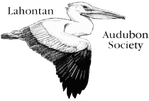|
By Jennie Jones Scherbinski Pinyon Jays (PIJA) are a species on the decline. These icons of the Great Basin have lost 80% of their population since the 1960s and continue to decline 3-4% annually. Despite these losses, there has been no coordinated conservation effort for this species, perhaps because the reasons for its decline are unknown. Various hypotheses focus on changes to the Pinyon Juniper Forests that the PIJAs call home, including fire suppression leading to denser less complex stands, increased drought, and active removal of Pinyon Juniper Forests to improve habitat for sagebrush species. There are several more hypotheses, however, conservationists need more information about PIJAs to untangle what is likely a complex combination of variables that are impacting this species. Pinyon Jays live in large flocks year-round that can consist of over 500 individuals, and breed cooperatively. As their name suggests, they are typically found in Pinyon Juniper Forests foraging on pinyon pine nuts, however, they have also been observed in other habitats and may follow pinyon pine nut crops or seek alternative food sources when no crop is available. PIJAs also cache pine nuts and may be using different habitats for foraging, caching, and nesting behaviors. Understanding how this species utilizes the landscape is a critical first step towards conservation, and thankfully, the Pinyon Jay Working Group is actively conducting research to help inform land management. Unfortunately, standard point count methods don't effectively capture population level data for this highly social species as they do for territorial songbirds. While PIJAs are usually quite conspicuous, they can be difficult to study due to their large home ranges and rugged habitats. Surveying for a wide-ranging species, like PIJA, requires extensive manpower and can greatly benefit from more eyes on the landscape. For this reason, the Pinyon Jay Working Group is looking for community scientists to improve our understanding of this species. Community scientists can take opportunistic surveys whenever they are out exploring within the PIJA range or can be assigned to key locations where we need additional data. Surveys will identify both the presence and absence of PIJAs, and the data will be used to better understand where and how this species is using the landscape, which will in turn allow for better management of their habitat. Lahontan Audubon Society, in partnership with the Great Basin Bird Observatory, will be holding training sessions for anyone interested in helping this conservation effort. We welcome birders of all levels to participate and no prior experience is required. We are finalizing training details, and if you are interested in participating, please fill out the volunteer interest form to be put on our contact list (PIJA Surveys can be found under the Conservation Committee heading). You can also check out the recording from our December Meeting with Great Basin Bird Observatory to learn more. |
topics
All
Archives
July 2024
|


 RSS Feed
RSS Feed